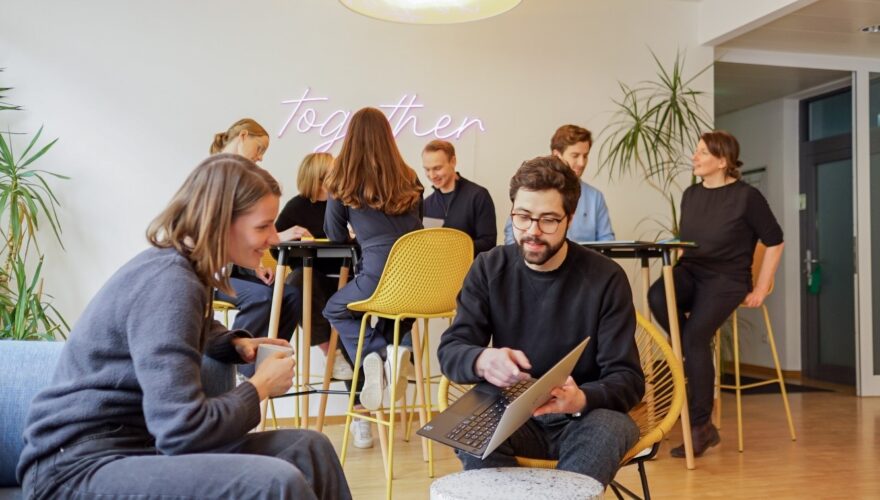How can we nudge people in adopting positive social behaviour amid and after the COVID-19 pandemic?
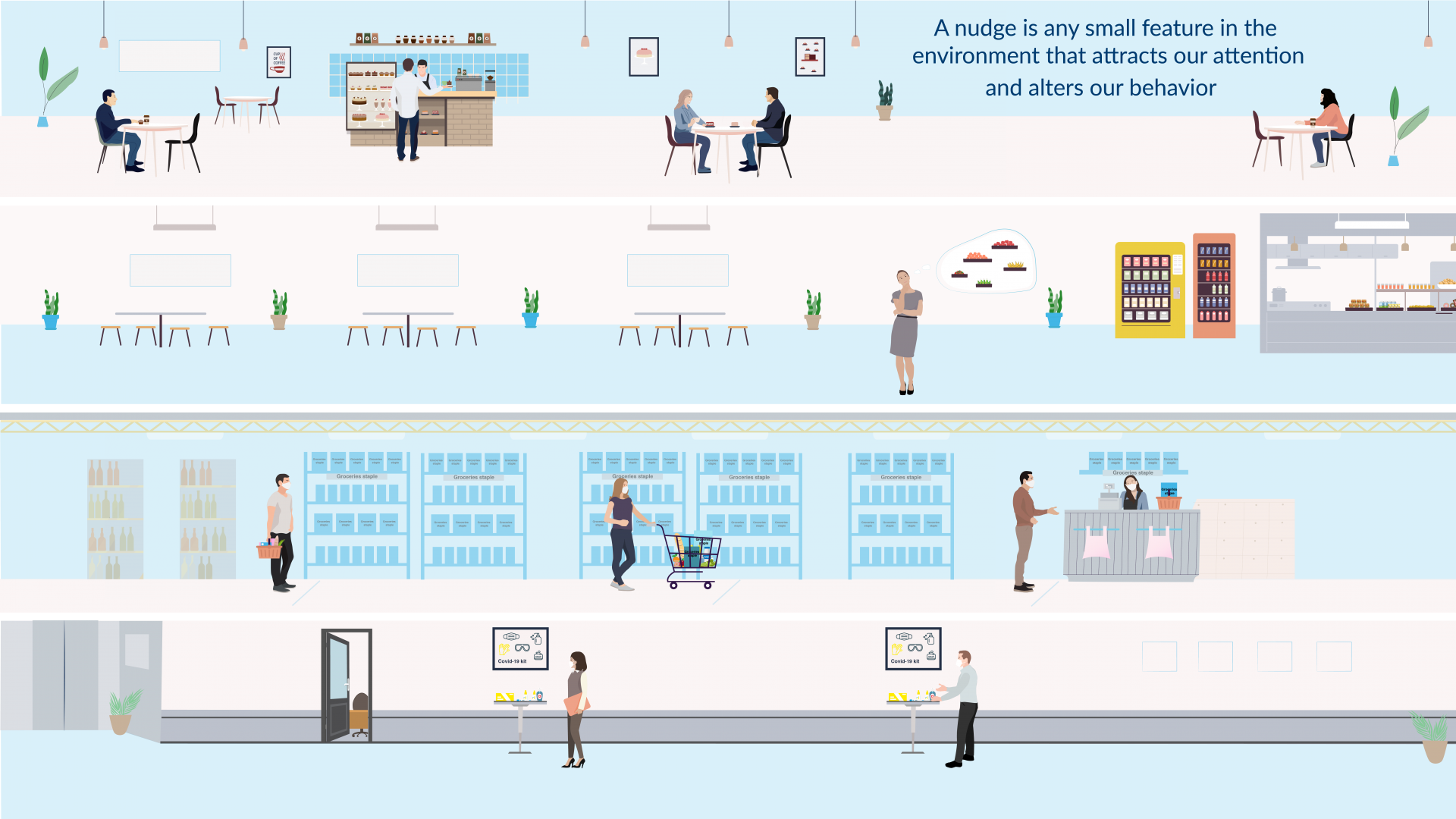
Let´s take a closer look at the Nudge theory and how it can support us facing the upcoming challenges.
- Hello, I would like a cappuccino.
- Of course, and what would you like for breakfast?
That is how you end up with a huge, overly sweet cinnamon bun.
You were supposed to just sip on your cappuccino and now you find yourself munching on the sugary treat.
How did that happen? That was a nudge.
A nudge is any small feature in the environment that attracts our attention and alters our behavior.
The Nudge Theory has been discussed for many years; however, it is in 2008, thanks to Richard Thaler & Cass Sustain and their bestselling book ” Nudge: Improving decisions about health, wealth and happiness”, that the Nudge theory entered the limelight.
But what is a nudge?
It is a concept from behavioural economics, political theory, and behavioural sciences.
A nudge is any aspect of the environment that can alter people´s behaviours in a predictable way without excluding any opportunity or significantly changing their economic incentives.
Was that too abstract? Let´s try with an example.
You have been given the task to come up with a solution that could help kids in high school introducing more fruits in their diet without drastically changing the menu that the school offers.
You know that the cafeteria offers fresh fruit every day, but students never pick a piece of fruit when choosing their meal. What could you do to increase the intake of fresh fruit?
That sounds like a challenge.
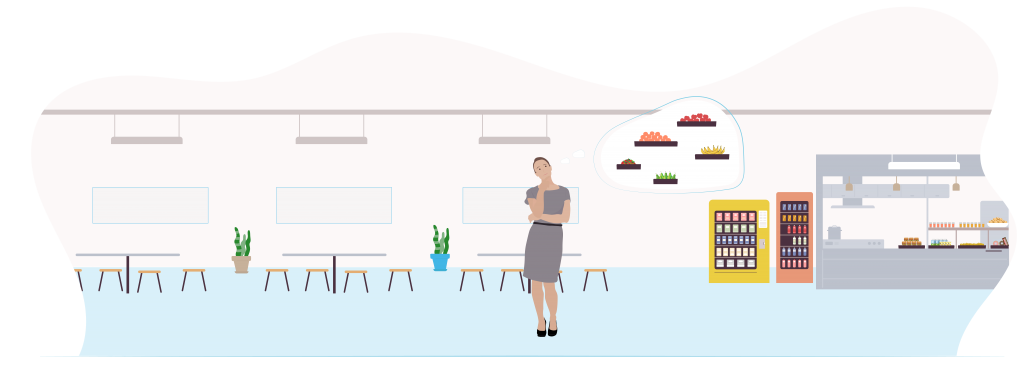
As humans, we use many ways to make sense out of the world and make decisions. And, not all our decision-making processes involve writing a list of pros & cons. Sometimes it feels we just chose something without giving it too much thought, right?
This is when our biases and heuristics come to play.
Think about biases and heuristics as shortcuts we take in order to make effective decisions. They are not always successful, but definitely work most of the time. They are a way to automatize our internal processes and avoid spending our days writing pros & cons for every single little choice.
Nudging exploits our biases and heuristics to guide our decisions in a specific direction, without us even noticing that we are being nudged.
Nudging make us act ‘reflexively’, rather than ‘reflectively’.
Any inspiration yet on how to nudge students into eating more fruit? Here are some suggestions.
We could just change the position of the fruit baskets at the cafeteria. Instead of placing it at the end of the line, when students have already picked their meal, we could just move the fruit basket at the very front, so that the fruit basket is the very first thing the students see.
Numerous studies showed how successful this little nudge was: the basket became empty before all the students could pick their piece of fruit for their lunch. Without changing the menu or banning junk food and desserts, students naturally gravitated to the fruit basket, because it had been made salient, it had been brought to their attention that fruit was available to them.
Since the publication of Thaler’s & Cass’ book, the nudge theory has been applied to many fields successfully, from physical to digital environments, from pension schemes to organ donations, and governments across the globe have now their own Nudge Units to help tackling many social challenges.
We are now facing one of the greatest social challenges ever.
We are currently asked to put life as we know it aside, and to change our habits and behaviours in order to collectively help managing this difficult situation. We are now aware of the great power we have, for better and for worse.
As businesses, brands, developers, designers and researchers we can make a huge impact in shaping and supporting the new normal and making people in our communities the best version of themselves. We can use the power of nudges to our advantage.
Here are some inspiring examples of nudges that could foster the adoption of positive social behaviour.
Supermarkets are the stronghold of nudging
Let´s consider the tills. Always filled with candy and chocolate bars or crisps for that last minute pick-me-up. We have been so good at sticking to our healthy list. Waiting at the till is the perfect moment to entertain the idea of treating ourselves for our good behaviour.
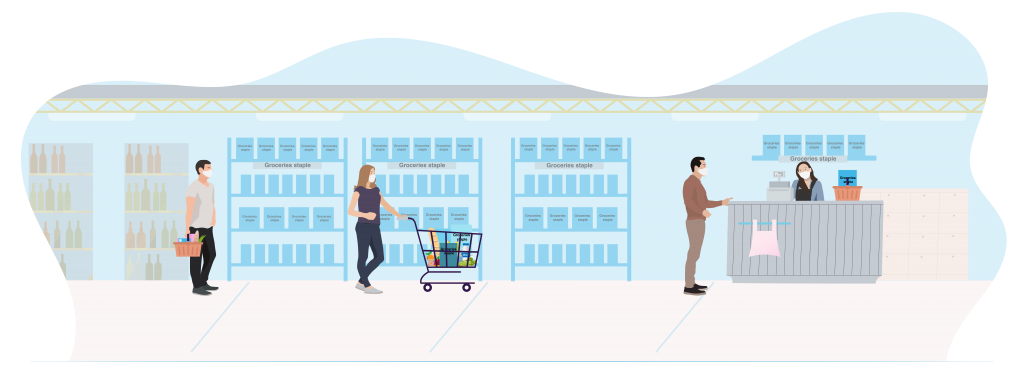
Or here we are picking up a veggie soup, minding our own business, when we are suddenly hit by the sublime buttery smell of freshly baked croissants from the bakery section, which cause an almost perfect pavlovian reaction in us: salivating at the idea of biting into one fragrant French pastry. How many of us have been tricked like this? I raise my hand.
Supermarkets have also been our only escape from home confinement, making them perfect places to engage in some needed social interaction, but also bringing our most vivid nightmares of germs and bacteria to life.
So how can we use nudges to make supermarkets a safer place for customers and employees alike?
Here are some of the initiatives that are already in place, in the process of being deployed or that could be implemented:
- Instead of having one product category per aisle (e.g. the bread aisle, canned food aisle, etc.), having a mix of basic products for each aisle could help avoiding gathering and long queues of people waiting to pick up some basics.
- Creating smooth paths with no sharp turns in stores to avoid congestion.
- Indicating the safe distance by taping it on the floor to make sure people stay in line correctly and respect the safety measures.
- Creating bundles of necessary products, so that shoppers can easily grab those and pay, accelerating turn-over.
- Playing messages over the speakers providing tips and useful information on how to make shopping safe for all customers, would help making the right information always salient to shoppers and therefore, they would act accordingly.
- Removing handles, buttons, and all surfaces coming in constant contact with the customers’ hands.
- Communication through messaging and social media apps how much groceries an average household needs could help in changing shoppers’ behaviour and avoid the hoarding behaviour we witnessed in the first weeks of lock-down (in German Hamstereinkauf).
Workplace environments also pose a serious challenge
With the diffusion of the open office layout, companies can squeeze more employees in smaller spaces; however, this does not comply with the new safety measures to contrast the pandemic.
Many companies are resorting to hybrid practices: having some employees work in the office and some others work from home, or creating specific weekly schedules in order to allow only a safe number of people to go into the office at given days.
Other practices are, for example, spacing desks, taping safety distance bubbles on the floor, providing employees with instructions, mask and gloves and moving in the office only clock-wise, in order to avoid making U-turns and avoid creating gatherings.
Another suggestion to foster healthy behaviours is creating make shift areas.
As soon as the employees enter the office, the first room they enter is a locker-style room, where they are prompted to wash their hands and disinfect their belongings, sometimes even to change into clean clothes, providing as super-safe entrance in the office. At HYVE, we have also placed disinfection tables in every floor in front of the main doors: colleagues and visitors can find masks, gloves and disinfectant, and can start their day safely.
Push notifications at regular intervals or specific times of the day could remind people working in the office to open the windows and/or sanitize their hands. A specific sound/tone would be required to differentiate this notification from the work related ones.
These measures are going to require a shift in how we think our daily tasks and life: the help of well-thought nudges could be a useful drive to positive social behaviours.
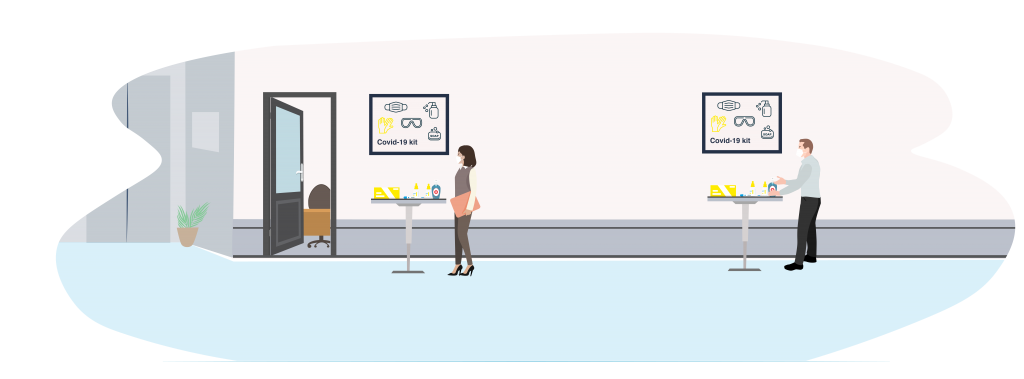
Let´s remember that nudging does not mean helping people in changing their habits and behaviours, but creating an environment that makes the adoption of new habits and behaviours the natural and logical consequence. Designers, product managers and business leaders should take an active role in creating such environment.
At HYVE we conduct user research in many different fields and we hear the users often say:
“I do not need a service or product to tell me what to do.” *
*Adapted quote from real participants to comply with privacy regulations.
The nudge theory encourages a human-centric approach over an authoritarian one, letting users be themselves without impositions in order to achieve the desired outcomes.
Design thinking and behavioural insights have a lot in common. They both care deeply about the user, and their journey with a product or service. They want to understand their needs, their motivations, their wishes, but also their struggles and difficulties.
Keeping the human needs in focus, despite the sweeping changes we are about to face, is going to be the key to build successful innovation that can bring out the best in ourselves.
